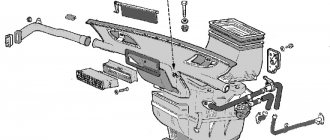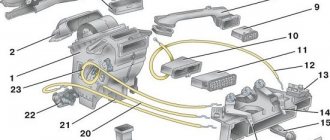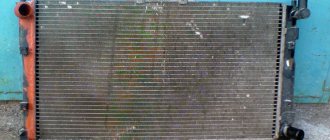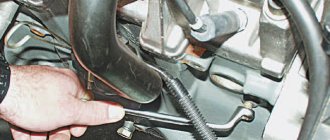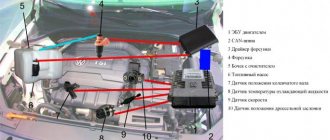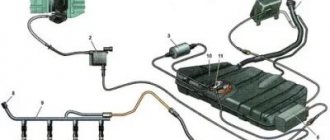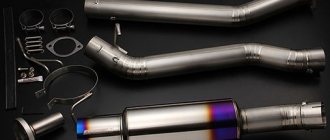VAZ 2114 owners often encounter the problem of uneven heating of the interior. Driving a car in comfortable conditions is much more pleasant and safer. And in winter this is especially true. Due to the warm breath of the driver and passengers inside the car, the windows are covered with an ice crust. This obstructs your clear view of the road and may cause an accident.
Before you start tuning the VAZ 2114 heating device, you need to understand the principle of its operation. It all starts in the cylinder head. Through it, then through the tap, antifreeze is supplied to the radiator. Then along the tube to the pump. Heating to 95 degrees, the coolant forms warm air. This is what goes into the car interior.
Using a faucet, you can regulate what air will flow: warm or cold. And also the fan speed. The dampers determine the direction of air supply.
- Causes of insufficient heat
- When Rework Is Needed
- Replacing the faucet
- Radiator tuning
- Refinement of the pipe
Preparing for replacement
The negative terminal is disconnected from the battery. Then, using a 10mm wrench, unscrew the 16 screws holding the engine splash guard.
Removing the mudguard is not so easy
Next we will drain the antifreeze. Unfortunately, on a VAZ-2114 there is no other way to replace the faucet. And on the 11183 engine, to do this, remove the ignition module with the bracket (three 13mm key screws). The main thing is to open the cap on the expansion tank, disconnecting the sensor connector from it.
First, the antifreeze is drained from the engine, then from the radiator. Using the “13” key, unscrew the cap on the engine, replace the container... Then we do the same with the radiator cap (see photo).
Two drain plugs
Both plugs will need to be tightened.
The rules for choosing antifreeze were discussed earlier. By the way, when draining old antifreeze, do not leave the stove tap closed.
What to check
Before replacing the faucet, you need to make sure that:
- The network is de-energized;
- The car is secured with a handbrake;
- There is no liquid in the cooling system.
But first, check
However, before you start disassembling the stove and making technological changes to its operation, find out that other components of the system are working correctly. Improvements will not yield results if the problems lie elsewhere.
- Make sure the pump is working properly. Breaking off the impeller impairs heat transfer. If the car begins to overheat frequently in the summer, and the heater does not work well in winter, this may indicate this problem.
- Make sure the thermostat is working properly. If it is stuck closed, the stove does not heat up at all. Antifreeze does not go into a large circle. If it is stuck open, the car (and with it the stove) heats up very slowly, the air comes out only slightly warm.
- Make sure the stove fan is working. It should work in all speed modes.
- Make sure your cabin filter is not clogged. Where is it? This is probably your problem. Open the hood, you will find it in the part between the engine compartment and the passenger compartment, approximately in the center.
- Make sure your heater core is not clogged. It is recommended to wash it periodically (every 2-3 years) using special products.
And only after making sure that modernization is necessary and everything else works, proceed to disassembling the VAZ 2114 stove and modifying it. This is quite possible and even necessary to do it yourself. Car service centers are unlikely to undertake such work.
Airlock
If the stove on a VAZ 2114 does not heat well, the reason for this is airing in the system. The plug may form after the engine is turned off, when the temperature of the antifreeze drops. It is at this time that air can enter part of the radiator from the expansion tank, which will then “get stuck” in the area of the thermostat. Upon subsequent startup, the system will circulate air instead of coolant, which will cause the engine to overheat and the heater to malfunction. How to get rid of this traffic jam? To do this, motorists loosen the coolant pipe clamp and slowly add antifreeze to the expansion tank to the maximum. By the way, you cannot mix different brands of coolant - the system may foam. Therefore, we add only the brand that was used previously, or use distilled water. The latter method is used in any season, with the exception of winter, since water at subzero temperatures will simply freeze in the tank. The antifreeze itself should be as transparent as possible (factory color does not count), and slightly oily to the touch. If it has not been changed for a long time and has lost these properties and has become cloudy, then it is better to drain it entirely and use a new “anti-freeze”. If the stove does not heat well (including VAZ 2114 1.5), you can get rid of the air lock in another way - simply drive the front of the car up an incline and open the cover of the expansion tank. After waiting 3-5 minutes, the system itself will push out all unnecessary air.
The device of the stove on a VAZ-2114 car
The connection diagram for the VAZ-2114 stove should be known to absolutely everyone who has come to the conclusion that the heater needs to be replaced. In order to do everything as correctly as possible, you should not forget about the need to disconnect the ground wire, otherwise the battery will not tolerate such treatment. At the same time, it is imperative to drain the antifreeze from the cooling system of the power unit.
The design of the VAZ-2114 heater is such that to replace the structure, you will have to dismantle the dashboard along with the lining of the floor covering tunnel. After this, it will be necessary, with extreme caution, to disconnect the air duct through which a warm air flow is supplied to the cabin.
In order for the heating to start functioning properly, the motorist must perform similar manipulations with the electrical wires that are connected to the resistor, the electric power unit of the fan, as well as two faucet hoses (with inlet and outlet).
After this, you need to remove both nuts that secure the faucet to the front panel. Removing the seal, which is located on the faucet tubes, will allow you to carefully remove the four nuts securing the heating unit to the car body.
If a motorist understands the structure of the stove in a VAZ-2114 car, he will be able to carefully remove the old heating device and install a new unit in the vacant space in the opposite order to its dismantling. It is important to remember that at the end of the procedure everything needs to be checked and adjusted.
Causes of poor-quality stove operation
Based on the complex structure of the stove, it becomes clear that it may not work correctly for many reasons. A malfunction of at least one of the components and components of the heating system can lead to a malfunction of the stove. In this case, a malfunction may occur due to the driver’s fault, or it may be a consequence of aging or incorrect operation of other vehicle systems.
Problems with the stove can manifest themselves in the following ways:
- Poor interior heating.
- Cold air from the stove.
- Variable temperature of air supplied from the stove.
- Weak flow of hot air from the stove.
- The heater in the car does not turn on.
Knowledge of the structure of the stove itself and possible breakdowns will make it possible to avoid large expenses when repairing a car. Let's look at the most common causes of poor-quality stove operation below.
Fan doesn't work
A fan malfunction can often be one of the problems with heating the interior. The cause of this failure is usually damage to the bearings or graphite brushes, which may require complete fan replacement. Also, the fan may be faulty due to the blown fuse or relay in the electrical power circuit, which is also a reason to contact a car service center.
If the fan makes a whistle during operation, and its rotation speed changes from minimum to maximum and vice versa, then the cause of the problem may be a failure of the fan motor. In such conditions, the radiator may remain hot, but it will not be possible to warm the interior to the desired degree.
Insufficient coolant level
A malfunction of the stove can be caused by a coolant leak, as a result of which heat stops flowing into the cabin radiator in the required volume. This in turn leads to a decrease in the volume of antifreeze in the expansion tank. To fix the problem, you need to find the location of the leak, add antifreeze to the expansion tank, and sometimes it may be necessary to replace the coolant supply valve.
Engine pump faulty
The pump is used to circulate antifreeze and to ensure proper functioning of the stove. If such a pump breaks down, a malfunction may occur in many engine components, including the vehicle interior heating device.
A malfunction of this part can be caused by wear on the inside of the impeller, a broken crankshaft belt, or even jamming of the pump itself. It is better to eliminate this kind of problem by completely replacing the pump, and to avoid such breakdowns, it is recommended to regularly check the hose leading to the pump, and also listen to sounds under the hood.
Blown engine head gasket
The head gasket is designed to connect the block and the car engine head itself, ensuring tightness and preventing coolant and fuel from mixing with each other. Burnout of the gasket in the engine cooling jacket leads to the generation of exhaust gases, which can enter the cooling system through the pipes. In this case, the heat exchanger becomes airy and the efficiency of its operation decreases, the coolant can heat up, and malfunctions are observed in the operation of the stove.
Thermostat malfunction
The thermostat is a device directly involved in the circulation of coolant, so its malfunction will affect the air temperature in the cabin. Since the thermostat can be in an open or closed position, its failure is characterized by jamming in one of these positions.
If the thermostat is stuck in the closed position while driving in city traffic, the temperature of the antifreeze may increase, and subsequently the engine may overheat. When stuck open, the interior temperature will be low when driving in high gears, while the temperature will remain normal at low speeds.
Heater core blockage
The heater radiator can become clogged for various reasons, and this can happen both from the outside and from the inside. For example, the outside of the radiator may become clogged due to dust, leaves, and insects entering through the protective casing. On the inside, clogging occurs due to dirt and deposits that can form in the engine cooling system.
Cabin filter clogged
A heavily contaminated cabin filter is one of the common causes of stove malfunctions. Many drivers treat it quite dismissively and do not replace or throw away the old one for a long time.
It should be remembered that a clogged filter is an obstacle to the flow of heated air into the cabin. In addition, when the filter is clogged, dust and mold spores can enter the cabin and accumulate in the filter itself.
The first “jamb”: the stove tap
The first problem area of the VAZ 2114 is the valve at the antifreeze inlet into the stove. On the one hand, its undoubted advantage is that if you accidentally break off the fitting on which the pipe is placed, it is enough to replace the tap. For example, on most foreign cars produced in the 90s, these fittings are an integral part of the heater radiator. If they are broken during repairs, you will have to replace the entire radiator. But on the other hand, due to this design, the quality of coolant circulation is much worse. And that means comfort from being in the cabin.
In addition, the supply of hot antifreeze for the stove is controlled mechanically on the VAZ 2114 using a cable. And this cable becomes dirty and “pulled out”. The fastening of this cable itself may weaken over time. As a result, the stove will not work properly.
Usually, if problems arise with cold air from the stove, it is recommended to tighten the cable.
Adjusting the heater tap cable
The problem arises due to the general unreliability of the mechanical cable system for controlling the interior heating controls on the VAZ 2114. We have already talked about this. Loosening or pulling the cable over time leads to the fact that the stove tap no longer closes (opens) completely when moving the slider on the control panel. To solve this problem, you need:
- Find the control cable for the stove tap. It runs under the panel near the gas pedal.
- Pull the cable so that when the damper is fully open, it also opens fully. Sometimes, with a strong stretch, the cable is shortened a little for this purpose. Do not overdo it, otherwise the tap will not close. Warm air will continue to blow in summer.
This basically works. But it may happen that you have to tighten it regularly. Often the problem returns periodically. The fundamental measure to solve it is the following method: removing the tap from the system.
Removing the stove tap
This modernization allows you to exclude an “extra” element from the system, improving the overall efficiency of the system (by improving circulation) of the VAZ 2114.
The operating procedure is as follows:
- Remove tap.
- Make (you can’t do without a lathe) a tube of the required shape, connect the pipes to it.
- To improve circulation, a pressure pump is additionally installed in the system (this is standardly installed on GAZelle, you can find it in GAZ spare parts stores). The pump runs on electricity. We recommend turning on power to it through a switch installed in the cabin in order to be able to forcibly turn on the pump if necessary.
We recommend using this tuning method only in regions with cold winters (where the temperature is around -20 degrees Celsius or lower for more than one and a half months a year). In all other regions, a standard stove should be enough!
Causes of radiator failure
The need to replace the stove radiator arises in several cases. If the heat exchanger remains cold even when the heat supply is set to maximum, it is highly likely to become clogged. The reason is scale that forms at high temperatures and settles in the radiator tubes or pipes connected to it. The second reason is a burst and depressurized radiator or pipes. When this breakdown occurs, antifreeze begins to flow into the passenger compartment on the passenger side, the mats become wet, and a characteristic unpleasant odor appears in the car.
In both cases, be it a cold heater radiator or an antifreeze leak, this unit will need to be replaced, since it cannot be repaired. Copper heat exchangers can be temporarily soldered, but this will not solve the problem for a long time; the part will still need to be replaced. This must be done as quickly as possible, since driving a car with a damaged heating system is uncomfortable and can be dangerous, since fogged or frozen windows impair visibility.
Instructions for replacing the cooling system pipes of the VAZ-2114
Step-by-step replacement of cooling system pipes in a VAZ-2114 car looks like this:
- Remove the battery cable that comes out of the negative socket.
- Carefully drain the old coolant, but wait until the engine has cooled completely before doing so. Otherwise, there is a risk of getting burns from the coolant.
- Remove the following components: set aside the upholstery that provides sound insulation, the fan, the trim going to the windshield frame, the facing material.
- Now your goal is to get to the air collector; to do this, unscrew the brackets in the form of springs and the screws responsible for fixing them. A screwdriver is ideal for spring clips; for screws, you need a wrench.
- To loosen the clamps, remove the front housing, and then remove the old hoses from the fittings.
- All that remains is to install new silicone hoses in a specially designated place; it is preferable that the parts are manufactured abroad - they will last longer.
- Reinstall the other components by following the reverse order of this step-by-step instruction.
Replacement instructions
The radiator is a replaceable unit, so if it is faulty, it needs to be replaced.
The replacement procedure consists of the following steps:
- First of all, you need to drain the coolant.
- Next you need to dismantle the dashboard. You can remove not the entire tidy, but only part of it to get to the radiator. How to remove the panel is described in the operating instructions.
- Before replacing, it is necessary to disconnect all wires and hoses that go to the radiator.
- Then you need to unscrew the fasteners and dismantle the unit.
- The removed radiator must be cleaned if it is clogged. If it leaks, it needs to be changed. Assembly should be carried out in the reverse order (video author - VChSLV).
WHICH TAP IS BETTER?
All owners of VAZ 2114, 2115 and other models unanimously claim that the original faucets that are equipped with the stoves of these cars are the most unreliable. The locking mechanism is a rubber membrane. Aluminum housings are susceptible to corrosion and quickly turn sour. True, the price of these parts is low - 80-120 rubles. Apparently, the price is calculated on the fact that the faucets will change every season.
Ceramic faucet is considered the most wear-resistant
But car owners don’t want to crawl under the car every time it gets cold, spoil their shoes with leaking antifreeze, and freeze inside the car. Yes, and this is a troublesome task - replacing the faucet on the VAZ 2114 stove. Therefore, motorists give preference to more reliable models of faucets:
- ceramic, their locking mechanism is made of ceramic plates, and the body is made of high-quality plastic;
- Ball valves, the locking element of which is a ball with holes.
Most VAZ 2114 owners prefer the Yavva ceramic faucet as one of the highest quality and most reliable. Although these models have lower heat transfer than ball models. The latter are susceptible to oxidation, but to a lesser extent than the duralumin models of AvtoVAZ cranes.
Work order
Replacing the radiator of a VAZ-2114 stove without removing the dashboard allows you to save time, and this does not require any special skills. Let’s immediately make a reservation that part of the torpedo will still have to be disassembled, but the center console will remain in place, and this is the most labor-intensive part of the operation. At the initial stage of work, the side part of the panel on the passenger side is removed; to do this, use a screwdriver to unscrew the screws securing it.
To drain the coolant, you need to unscrew the bolts of the front protection, which is located under the engine compartment. The antifreeze is drained through a special plug located in the cylinder block; to unscrew it, you will need a 13 mm spanner. To prevent it from spilling on the ground or the garage floor, a container is placed under the car. To increase the rate at which antifreeze flows out, you can open the cap of the expansion tank.
Using a hexagon on the passenger side, the torpedo mount is unscrewed, after which it can be easily bent.
Next, you need to unscrew another fastener, located on the passenger side under the lower part of the center console. After this, the torpedo can be easily raised so that it remains in the same position, a stop of suitable length can be installed under it; a block with a cross-section of 50x50 mm and a length of about 40 cm is enough.
In the opened space you can see the heater radiator, which is attached to three self-tapping screws. They must be unscrewed so that it can be safely removed from the socket. In this case, a problem will arise - another self-tapping screw is hidden behind the plastic body of the torpedo, which needs to be unscrewed. To get to it, it is advisable to drill a small hole in the plastic through which you can insert a screwdriver. To do this, you first need to remove the glove compartment. If you try to move the torpedo, you can break the plastic and then removing the heater radiator on a VAZ-2114 will turn into an expensive procedure.
Next, you can proceed directly to dismantling the heater radiator. To do this, remove the clamps and disconnect the pipes, under which it is better to place a small container or rag, since there is still antifreeze in the system, which will spill directly into the cabin. After this, the radiator is removed from the mounting socket without any effort. It is advisable to examine it to see where the damage was and where the antifreeze is leaking from; corrosion damage appears in this place and streaks are visible, which once again confirms that the stove radiator needs to be replaced.
The new heater core fits into place effortlessly and should not cause any problems. It is secured with self-tapping screws, including through a hole previously drilled in the dashboard. In this case, it is advisable to inspect the faucet, since this is another weak point of the heating system. It should be completely dry and the lever should be easy to turn. The glove compartment is installed in place, the dashboard and the removed side panel are screwed to the mounts.
Before adding coolant, you need to check whether the plug on the cylinder block is tightened so that the coolant does not spill out. Fresh antifreeze is poured into the expansion tank to the level; if during operation the level drops, it will have to be topped up.
To carry out the tests, you need to start the engine and, after waiting until it warms up, turn on the heater. It should heat well in different modes, and the interior should remain dry, without stains of spilling antifreeze with a characteristic odor. At first, it is recommended to periodically look at the floor to make sure that all connections are tight and the new radiator is not defective.
Video: Replacing the heater radiator WITHOUT REMOVING THE TORPEDO
Stove control
The control of the flaps and valve on the VAZ-2114 remains mechanical and remote, just like on the VAZ-2109. The heater control unit on this car consists of three sliders (lever) and a knob for selecting the fan operating mode. The sliders are connected via cables to the stove tap and dampers. To control the heater, the driver moves the sliders, acting on the dampers and tap.
The control mechanism for the VAZ-2114 stove is implemented in an interesting way:
- The lower slider is connected by cables simultaneously to the tap and the main valve. When moved to the extreme left position, the valve opens, and the damper provides hot air into the cabin through the radiator - the stove operates in heating mode. By moving the slider to the extreme right position, the driver closes the tap, and the damper directs air bypassing the radiator - the heating system operates in interior ventilation mode.
- The upper left slider is responsible for directing air to the footwell area or through the air ducts for heating the side windows and supplying heat to the cabin (central deflector).
- The upper right slider is connected by a cable to the air supply flap to the windshield area.
Causes of insufficient heat
The ability to understand and feel a car means a lot. Some possible problems noticed in time can be easily eliminated by tuning. What can cause poor heating?
Firstly, the fan is not working. It's three speed. And if the fan does not work at any speed, then it should be replaced. The resistor could also be the culprit. When the fan starts working only at speed 3, replace the additional resistor.
Secondly, the thermostat. When the engine is running, the connecting pipe (thermostat - radiator) remains cold. Otherwise, you need another thermostat.
Thirdly, the filter is clogged. On older VAZ 2114 models there is no such filter. On new ones it is located under the heater casing. If he is the culprit, we need to install another one.
Don't let your filter get into this state.
Also, the cause of poor interior heating can be an air lock, insufficient or absent coolant in the expansion tank, the inability to fully open the heater tap, or a dirty radiator.
Heating system VAZ-2114
The VAZ-2114 interior heater consists of the following elements:
- radiator with pipes;
- supply shut-off valve;
- frame;
- air ducts;
- dampers;
- fan;
- Control block.
Heating of the air supplied to the cabin is carried out by passing the air flow through the honeycombs of a heat exchanger - a radiator, through which coolant heated by the engine circulates.
The VAZ-2114 heater has the ability to shut off the supply of antifreeze to the heater radiator, so the heating system is turned off (for the summer period). The supply is stopped using a tap embedded in the coolant supply pipe to the heater radiator.
The radiator is installed in the heater housing. In addition to housing the component elements of the stove, the housing prevents the dispersion of air flow and directs its movement.
The heater body is connected to air ducts, with the help of which it supplies heated air flow to the areas of the windshield and side windows, to the middle of the cabin, to the feet of the driver and front passenger. To adjust the direction of air flow, deflectors are installed at the ends of the air ducts that supply heat to the side windows and into the middle of the cabin.
The distribution of air flow across zones is ensured by dampers installed in the housing. The design of the VAZ 21-14 stove uses three dampers:
- Stove control damper. It redirects the air flow through the radiator (the stove is operating) or bypassing it (the system is operating in interior ventilation mode).
- Damper for supplying flow to the windshield area.
- Damper for redirecting warm air to the footwell area or to the side windows and into the passenger compartment.
Thanks to the dampers and the heater tap, the driver activates the interior heating system, controls the air flow, choosing which zone it should be supplied to.
The fan included in the heater design creates an air flow. Thanks to the power supply circuit of the fan electric motor being equipped with rheostats, the unit received three operating modes in which the fan rotates at different speeds.
Unlike the heating systems of cars of the classic family - VAZ-2101-2107, the fan in the VAZ-2114 forces air into the heater body, rather than drawing it in, which increases the efficiency of air supply. Therefore, this unit was installed not inside the housing, but on it. Access to the fan has become easier, since on the VAZ-2114 it is located in the engine compartment, in a niche near the engine shield.
Basic aspects of tuning
Car tuning is not only about illuminating the dashboard with LEDs. Tuning the VAZ 2114 stove is required in situations where cold air blows from the sides of the stove, or the interior is heated unevenly.
To do this, you need to remove the side cover on the gas pedal side. The clamps holding the throttle cable should be loosened. Then you need to pull it back and tighten the clamp. Next, you should install the damper control levers. From this moment on, warm side air should blow, warming the driver and passengers in the cabin.
Heating system repair
At the second stage of tuning, it is necessary to ensure that air coming from outside passes through the heater. The operation of the damper and the tap is carried out by the operation of one engine. It should be ensured that it does not control the damper. To do this, the right cover of the torpedo is removed, and then the one located on the right is disconnected and pulled from the two temperature control cables from the engine. The damper should be in its maximum position. The cable should be tightened and the excess should be trimmed.
Modification of the pipe is required if the air flow from the left deflector is too weak. It needs to be forcibly strengthened. To do this, you need to install a fan with a diameter of about 50 mm in the pipe. You can use a computer fan. First you need to remove the deflector. Then, having made a hole of the appropriate size, insert the cooler and seal it. Next, the pipe with the cooler needs to be returned to its place and the power supply restored.
You can connect the fan directly to the heater contacts. However, in this case, in order for it to work, you need to turn on the ignition.
If you properly modify the stove, it will work more efficiently. This will improve the comfortable conditions in the cabin of any car, both VAZ 2114 and UAZ. LED lighting will give the panel a beautiful appearance, especially at night.
REASONS FOR THE LACK OF WARM AIR IN THE VAZ 2114 INTERIOR
If you don’t know how the car works, you might think that the heater is not heating well only because of a malfunction in the heating system, but in practice there are many more reasons. Reasons for the lack of hot air in the car interior:
- The heater radiator is clogged, it may also be of poor quality;
- The heater motor in the cabin does not work;
- The heater tap is faulty, does not open completely or is completely closed. The crane drive cable may be broken (the cable of the VAZ 2114 stove);
- Air lock in the engine cooling system. The air in the system does not allow coolant to circulate normally through all pipes;
- The cylinder head gasket is broken. In this case, the engine on the VAZ 2114 heats up, antifreeze leaves the cooling radiator;
- Insufficient antifreeze level in the radiator. This problem can be solved simply - you just need to add coolant to the required level;
- The heater motor does not work. Here, too, everything is quite simple - if it does not make noise when turned on, then you need to look for the reason for the lack of heating of the interior in it. Although, the wiring going to the motor and the switch itself may be to blame;
- The heater control unit (heater switch block) is faulty. There are options here - warm air does not reach the windshield, does not blow into the legs, and there is no side airflow. The cables on the heater control may be torn (or flown off);
- The water pump (pump) in the engine cooling system does not provide the necessary circulation;
- Thermostat is faulty. The thermostat is required to maintain a certain temperature in the cooling system, but if it is constantly open, then circulation occurs in a large circle and the coolant does not heat up to operating condition.
Modernization of the VAZ stove. Simple Simple
way way to modernize the VAZ stove
In principle, the VAZ has a very good stove, it heats everything, but it does have a drawback. The VAZ stove is made in such a way that virtually no air flows into the left pipe on the driver's side window - a winter feature. But in the design of the period this is a significant drawback; you have to use a cloth or open the window, and this is not very convenient in winter. Upgrading the stove will not take up a lot of your time.
The point of installing is to upgrade a regular cooler from a computer into the pipe, which will force air from the stove. For, So, first you need to remove the deflector from the Do. the pipe is very easy.
Modernization Modernization
stove stove vases is carried out as follows:
image the deflector with a screwdriver and take it out. Pry it off.
forward with another screwdriver, pull out the other and the sides forward
Removing the deflector from the housing
The body is held in the torpedo by antennae
We insert the deflator into our hand and take it out of the torpedo without any effort. take Next 50 mm. cooler, it fits the pipe perfectly under the landing pad.
Next, we take measurements along the body center of the deflector and mark its dimensions. Using a hacksaw, we make cuts in the plastic.
We insert the resulting opening into the cooler. If the cooler is just hanging around, glue it down.
If the heater in the car does not work, especially in the cold season, there is a possibility of being left without a means of transportation, as in the cold you can simply freeze inside the car. In severe frosts, it is very difficult to clear the windshield of ice in order to ensure visibility, and with a non-working stove this becomes doubly problematic. You may not even be able to get to a service station.
But more often than not, if the working principle, diagram and design of the VAZ stove are known, 2115 it is possible to solve the problem right on the spot Device.
independent heating system VAZ-2115
The electrical diagram of the VAZ heater is represented by the following elements:
- Electric motor with fan. The hot fan drives air into the car interior and onto the windshield Buttons.
- glass and levers for switching the heat level and air flow rate. The VAZ-2115 has 3 speed options for heat flows, which can be additional.
- adjust the resistances that ensure the desired rotation speed of the stove fan (reducing tungsten turn fuses).
- coils and connection wires.
The diagram of the 2115-VAZ stove, presented below, clearly shows its operation, device and components.
Connection diagram for the VAZ heating system
Promotion: Sale of new 2022 cars - 2019 model year at the Moscow Automobile House
Promotion: Sale of new cars produced in 2019-2018 at the Moscow Automotive Assembly
- House block.
- Ignition.
- Unloading relay Switch.
- ignition of the stove engine.
- Additional resistor.
- stoves Motor.
- Stove control button.
- Heated rear window.
K7 is a relay that turns on the heated rear window.
Heater operation diagram
- Fan.
- blower Windshield flap.
- A damper that distributes air flows to the central and side deflectors; zones that warm the feet of the driver and passenger.
- Damper that controls the radiator.
- stove.
- Airflow to the driver's feet.
- Internal Work.
The stove air duct is based on the following principle
The cooling and heating system works the same on almost all VAZ models. The heater is turned on using a regulator located in the car itself; antifreeze is supplied to the radiator. After it warms up, the temperature reaches more than 80 degrees. After which the fan starts working, which only works in 3 speed modes.
The fan begins to create a directed air flow. It moves from the external heating system into the interior of the car. Using the control flaps, the driver selects heating zones, there are three in total: on the feet, on the windshield, and on the car window.
The key element of a car's heating system is the fan, and if it fails, the heating will fail. Without it, hot air will not flow into the cabin, and to heat the interior space of the VAZ-2115, it will take not a couple of steam, but minutes of hours.
Major electrical breakdowns of the heating system of the VAZ-2115
If no changes occur in the heating system at any switch position, then most likely the motor is out of order (the brushes are worn out) or there is no voltage at the terminals. But also in this case there may be problems with the ignition switch or the mounting block (fuse F4 has blown).
It is important for the operation of a proper car heating system that there is not 3 ohms at the engine ground (installed under the hood).
If the heater works normally at maximum engine speeds, and problems arise only at low speeds, then the cause of the malfunction most likely lies in the switching speed button or additional resistors.
If you turn on the interior heating system and hear noise, but the heater does not blow properly, then this also indicates a malfunction in the engine. Malfunctions may include jamming of the impeller or armature bearings. Malfunctions can be eliminated by replacing components or, if required, by lubricating them. But, as a rule, these actions have a short-lived effect and the problem returns.
Replacing the heater valve VAZ-2114
We drive onto a pit or overpass. We put the car on the handbrake and first gear. Drain the coolant into the prepared container. To do this, first, with the expansion tank cap closed, unscrew the drain plug on the engine cylinder block (if the tank cap is sealed and tightly screwed, then antifreeze will hardly flow). Then, instead of the drain plug, we screw in a hose (from a mixer works well) and open the reservoir cap - the coolant flows neatly into the container with minimal losses and without getting dirty on the engine.
We loosen the clamps of the pipes going to the valve from the engine. From the engine side, use a metal brush to clean the threads of the 2 bolts securing the faucet to the engine compartment bulkhead. Then we conscientiously treat these threads with WD-40 or brake fluid. This is a mandatory condition, failure to comply with which can lead to serious difficulties when unscrewing the nuts. We leave the dirt and rust on the threads to “acidify” and do not tighten the nuts yet.
We remove the pipes. Let's go to the salon. We dismantle the side trim of the torpedo in the middle at the feet on the passenger side. Loosen the clamps of the pipes at the tap. We prepare a rag to collect a small amount of antifreeze that may leak onto the carpet when removing the pipes. Disconnect the pipes. We return under the car. Using a 10mm wrench (socket or socket), unscrew the nuts of the faucet mounting bolts.
In the cabin, pull the faucet towards you. Then we remove the control cable clamp from it, and then disconnect the cable itself. We install the new tap in the reverse order.
Types of heater radiators installed on VAZ 2114/15
The manufacturer installs its own aluminum radiators on the VAZ 2114/15 with a service life of 3–5 years, after which the radiator is replaced. Selecting a new heat exchanger is quite difficult. There is a wide range of radiators from various manufacturers on the market. Of course, there are fakes.
Heating system radiators for the entire Samar family have catalog numbers 2108–8101060 and 2108–08101060–00 and the same dimensions:
- length - 250 mm;
- width - 158 mm;
- height - 42 mm.
The scheme of their attachment to the body is also identical.
Radiators for the VAZ 2114/15 stove are produced under catalog numbers 2108–8101060 and 2108–08101060–00
The VAZ 2114/15 can be equipped with aluminum and copper radiators, which have their own advantages and disadvantages.
| Aluminum | Copper | |
| Service life, years | 3–4 | 5–7 |
| Heat dissipation, W/mg | 209,3 | 389,6 |
| Maintainability in the event of a leak | Conditionally repairable | Repairable |
| Cost, rub. | 800–1000 | 1600–1800 |
The main advantages of copper products are longer service life, increased heat transfer and maintainability. However, they usually cost almost twice as much as aluminum ones. The technical characteristics of radiators are largely determined by their manufacturer.
Radiators DAAZ
The most popular among VAZ 2114/15 owners are radiators manufactured by Luzar, Hola, Craft, Pekar, etc. They are all in the same price category and have similar performance characteristics.
DAAZ radiators are highly efficient and have a long service life
DAAZ aluminum radiators have improved parameters. They have a service life of 4–7 years and a price of about 1000 rubles. The design features of such radiators include a larger number of lamellas (thin plates), and this significantly increases the heat exchange area. DAAZ radiators are the best option for VAZ 2114/15 owners.
Due to the larger number of lamellas, DAAZ radiators have increased heat transfer
Repair/replacement of resistor
A faulty resistor may be indicated by the fan operating in one mode, when manipulations with the switch do not affect its blowing speed. To replace the resistor, you need to prepare a screwdriver with a Phillips head, fine-grain sandpaper and a multimeter. Algorithm of actions:
- disconnect the negative terminal of the battery;
- unscrew the screws that secure the right console cover;
- Use a screwdriver to unscrew the screws securing the right cover of the center console;
- you will have access to the resistor, from which you need to disconnect all the wiring and evaluate the contacts for burning. If the contact surface is oxidized, use sandpaper to clean it down to metal;
- It may well be that the resistor has lost its functionality precisely due to burning/oxidation of the contacts, so we assemble everything in the reverse order and check whether the fan will work in all normal modes;
- in case of a negative result, again remove the negative terminal, the panel cover and unscrew the screw that secures the resistor to the body;
- We remove the resistor and use a multimeter to measure the resistance at the resistor inputs and at the inputs of both windings. In the latter case, the indicator indicating the working condition of the additional elements is 0.2 Ohm. For the entire resistor, the standard resistance should be 0.8 ohms. If the multimeter readings do not match the specified values, replace the resistor with a new one, and then reassemble in the reverse order.
Sequencing
Drain the coolant by opening the plastic tap next to the generator (at the bottom of the radiator). Remove any remaining liquid using a piece of hose and a funnel. After removing the air ducts, check the condition of the holes with the heater outlets on the panel. If they are not aligned and the misalignment is more than 50%, carefully trim the interior heater. After marking all the connectors with strips of colored tape (colored felt-tip pens), remove the instrument panel. Remove the steering wheel, steering column trim, steering column switches
Carefully dismantle the heater by unscrewing the nuts and removing the wire from ground. Having previously marked, disconnect the heater connectors. With the cable release and radiator hoses removed, remove the heater by removing the 2 fan screws.
Be sure to pay attention to the condition of the rubber washers and thrust bearing
- After unscrewing the 3 bolts, carefully remove the heater core.
Remove the radiator carefully. Residual coolant may leak out.
- Prepare turbulators (plastic spirals to increase heat transfer from the radiator). Spirals should be included at the factory, but are often not.
. You can cut turbulators (swirlers) yourself. Prepare aluminum (copper) plates with a cross section of 6 mm by 1.5 mm. Clamp one edge of the plate with a drill, the opposite edge in a vice and twist it with a spiral.
Check the bottom wall of the heater for deformations, displacements, holes, integrity problems and other defects. Integrity can be determined through the hole for installing the radiator. Carefully disassemble the heater, moving the body halves apart from each other. Use a suitable screwdriver to open the latches and remove the screw under the central nozzle. Sequentially remove the levers that control the flaps. Inspect the inside surface of the heater. Glue the foam rubber if it has peeled off and stick on the bitoplast strips. Bitoplast must be glued so that the body remains as tight as possible when the dampers are moved to the extreme position. Carefully adjust the center flap. Treat all fastening points of the dampers with grease. Before connecting parts of the heater housing, treat the connector surfaces with sealant. Reassemble the rebuilt heater in reverse order. If there is deformation at the bottom ribbed wall and a gap has formed during assembly of the housing, fill it with sealant. There should be no gaps between the radiator and the stove. Strips of regular foam won't do much good. It is better to glue bitoplast strips at the points of contact between the radiator and the heater. Balance the fan impeller, wrapping wire around the fan blades if necessary. Route the wires back through the housing rubber plug. Adjust the damper stroke. All levers should be easily locked in extreme positions
Particular attention should be paid to the levers of the central and main dampers. The adjustment is mainly carried out by selecting the positions of the braid
After adjusting the dampers, work on the heater valve. Structurally, the choice of partial opening/closing of the tap is provided. Determine the position in which the tap will not close completely. Before installation, treat radiator hoses and tubes with sealant. Replace all clamps with new ones. After complete assembly, filling with antifreeze and warming up the engine, tighten the clamps again. Then, before installing the panel, glue foam and bitoplast to the inlet holes of the air ducts, making sufficiently wide holes in them. In some cases, heater maintenance may not be enough to solve all problems. The question arises, how to insulate a VAZ 2114 for the winter so that the car warms up quickly and the temperature in the cabin is as comfortable as possible? If it blows from the doors or heat escapes through technological openings, the problem can be solved by replacing the seals and thermal insulation of the car.
